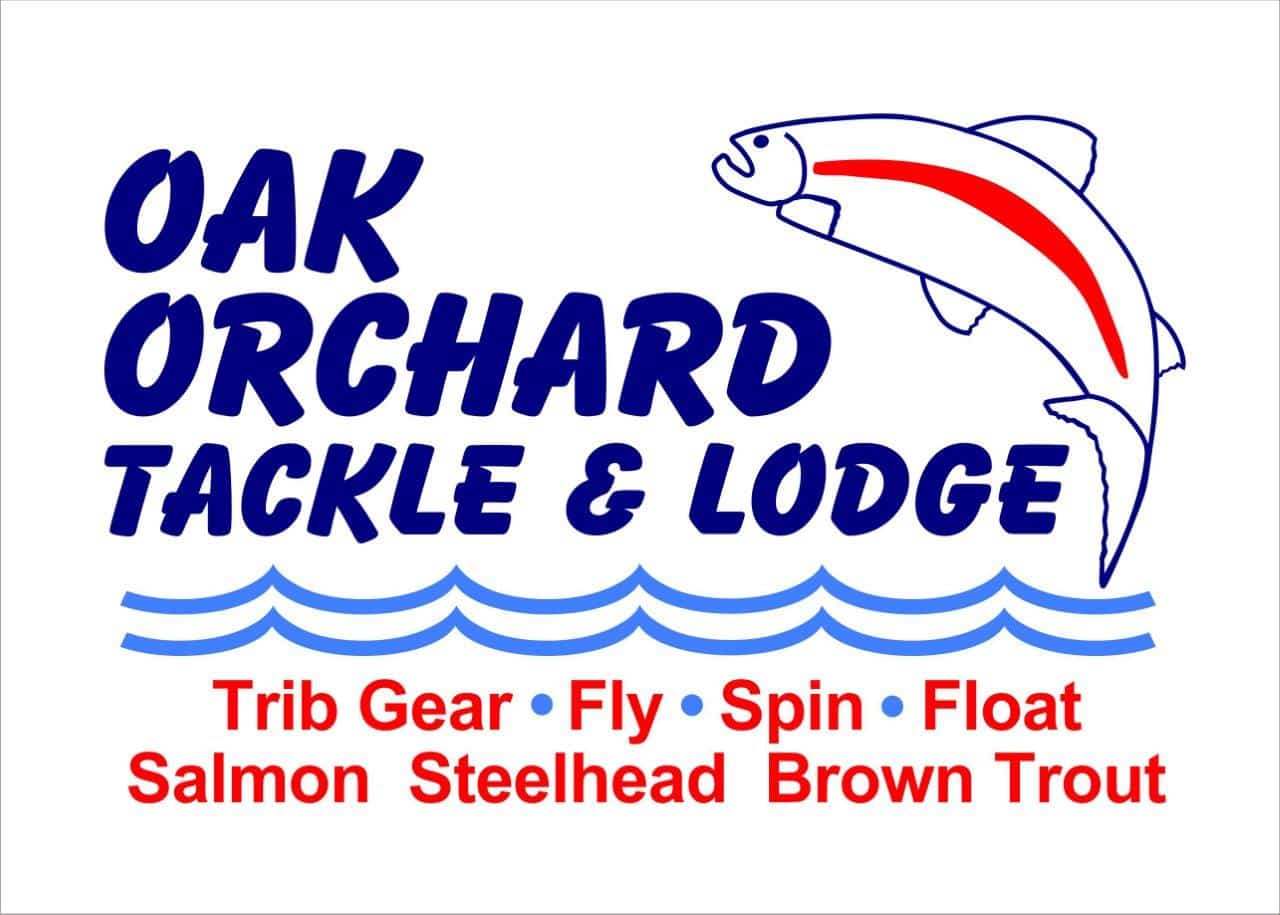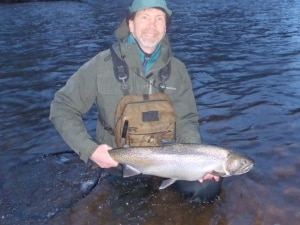When to Fish
One of the most frequent questions is, “when should I fish so that I will catch the most trout and salmon?” The quality of the outdoor experience shouldn’t be measured just by counting numbers of fish hooked, although a savvy angler can maximize his or her opportunities by staying informed of run timing, weather and flow conditions in the tributaries. By the dynamic nature and challenges of the cold water angling, there can never be any guarantees of hookup success.
Okay, so anglers should check on run timing, look for reasonable weather and make sure the river is not blown out. Even with that being said, most of the time we should fish whenever we can. Why? Because those three factors of strong runs of trout or salmon, good weather (read warm) and good flows (read medium & stained) almost never all come together. Waiting for perfect conditions to all come together can be a mistake. Waiting will lead to missed opportunities since weather usually turns again for the worse, trib flows are notoriously fickle and runs of fish quickly become stale or maybe even fished out.
Make the best of it. With the exception of blown out and muddy conditions, there are opportunities for hookups. That is especially true here in the Oak Orchard River and is largely a result of two upstream impoundments that moderate flow conditions. The tailrace below the Waterport hydro can keep the turbine channel fishable even as the overflow channel is raging. Sure, once the whole system goes out of shape it may take a while to come back. But, getting to that point will allow for fishable days long after other WNY tribs have gone out of shape. Here’s some other points to keep in mind.
Steelhead, brown trout and salmon migrations can change subtly each year. Generally, the tribs are short watercourses and trout and salmon don’t always fully commit to “run” in a given trib. The fish migrate in and out freely and stray. Weather can dictate fishable conditions and travel plans. Out of the area anglers always seem to think the weather will be worse here on the WNY lakeplain. Lake Ontario tends to have a moderating effect on the local weather. Fall and winter temps may be warmer then southern locations. And snow? Here in the Oak Orchard area anyway, we are not located in any particular snow belt, unlike the east end of Lake Ontario or to the southwest in Buffalo. Water flow is surely an important consideration in choosing a time to fish. And hydro power generation can foil the best laid plans. On an average however, expect fall flows to be low or moderate and clear; winter flows to be cold, clear and low; and spring flows to be high and off color.
Versatility
We all have a favorite way of fishing, be it fly, spin or float. Probably we all have a favorite place, time and flow condition too. And the experience when that all comes together can be special. That’s one intangible quality of the angling experience. But in order to maximize your time on the water, learning new techniques or methods and places to fish can make you a better angler and lead to a few more hookups.
First, you can learn different techniques for your favorite method of fly, spin or float. Dead drifting egg flies is not the only way to catch fish. Try a wet fly swing when water temps are favorable. Try some cast and retreive methods with sinking lines or heads for post spawn fish in slower waters, they’re often so ravenous the strikes you’ll get will be arm jarring. Try an indicator, you might be surprised at what you’ve been missing.
If you are a light line spin fisherman, you can drift any of the same flies that the flyrodders use. Don’t always turn down your nose at bait. Tip a jig with a grub or drift an egg sac below a float – it’s easily the most stress free way and one of the most productive ways to fish. Try casting and retrieving spoons and plugs at shoreline or lower river sections in the spring and fall. Again the rod wrenching strikes will really surprise you.
Try drifting a centerpin and long float rod. The dead drift presentation leads to the most controllable drifts you can imagine and snags will be far fewer then bottom bounce methods. You aren’t limited to just bait with the float rod. Flies and jigs work great and your hookups will be gauranteed true biters.
Using the different methods of fly, spin or float will put you on the water longer by utilizing the method that might work best under a given water condition. Low and clear? – then float fishing will probably work best. Fresh fish, semi stained water? – then drift your favorite flies. Early fall, late spring, no action in the tribs? – then break out the casting gear and extend your season on the lakeshore.
Check out some new fishing destinations. Even when in close proximity to one another, select ribs might be perfectly fishable when another is not. Even if you’ve just driven five hours and found your favorite waters blown out, continue on to a bigger or smaller trib and salvage the trip. Learning new water with a bonus hookup or two sure beats flogging your old hole that’s muddy and blown.
Show Support
Great Lakes tributary fishing is enjoyed largely by out of the area anglers. Native anglers are nearly always outnumbered by traveling tourists who are present just a few times a year (maybe just once) at the fishing destination. This scenario can lead to advocacy and support for the fishery coming from just a small band of native anglers and a few stakeholders. Become involved on any level you can campaigning for the trout and salmon resources. Afterall, the success or failure of your next trip could have a lot to do with what you might accomplish with resource managers and decision makers in the off season.
Support catch and release where practicable. Try to become educated in water flow/level issues and keep pressure on hydro power interests to manage for adequate stream flows and fish migration interests. Consider creel limits for steelhead and brown trout – afterall, no angler can enjoy the thrill of the hookup once the fish is in the cooler. Be careful of denied access on watercourses that leave few options for the non paying public. Be a part of fish pen rearing projects, nearly every major port or waterway on the shores of Lake Ontario have their own projects in the spring or fall. Call the game cops at every opportunity to report snagging or illegal harvest. The poachers are only taking away from the legitimate chances we all have for hookups.
Write letters, find out who the representatives are that you should contact regarding fishery concerns. Point out the obvious economic value that you as a traveling angler bring to the upstate NY local economies. The NYSDEC Region 8 headquarters in Avon, NY (585 226 2466) or Orleans County Tourism (585 589 3198) is the place to call for Oak Orchard River issues. Support the open water lake fishery, as goes the fishing out there, so can go the tributary fishing. Good salmon harvest in the open Lake often means more trout available for the tributary angler. Talk to local tourism and government departments about any concerns, big or small. Join a club like LOSA (Lake Ontario Steelhead Association, www.losafishing.com) that lobbies for the trout and salmon resources. Leaving the important decisions up to some else might lead to a slow erosion of the great fishing we all want to enjoy. Stand up for the trout and salmon fishery as if it were in your backyard, you may someday retire and choose a new backyard very close and/or want to introduce your kids to the great fishing that you enjoyed.
Get the Drift
Presentation and being in touch with your drift is an important part of a formula for success in the tribs. Except for true down & across and retreive techniques, drifting is the name of the game. Even for retreive or down and across techniques, there is still really a small element of drift in each presentation if not just for proper positioning of your offering. But for the fly, spin or float angler, knowing what your drift is doing and how to manipulate it, is likely the single most important variable that can be controlled for success or failure.
Good trib fishermen make it look easy at times because they understand what their drift or presentaion is doing in the water column and currents. They know that generally in cold water presentations the fly, bait or lure most be near the bottom. They know that achieving a bottom drift has more to do with line diameter, leader length, float selection, fly dressing, rod positioning, etc… then with clamping on more weight. Someone in touch with their drift can tell you how deep the water is, if it’s rock or other bottom, what the currents are like under the surface and even if the last tap was a fish striking or a snag. Therein lies an important point, without keeping in touch with your drift, you’ll never even know if you are getting a strike or at a minimum not be prepared to set the hook for a good hookup.
Getting the drift right means keeping tight to the drift. Tight enough that is, to know what is going on on the business end but not so tight as to make drag. And being too loosely connected to the drift just leads to too much line in the water and drag again. But keeping just tight to the presentation allows for proper manipulation and mending, complete coverage of the water, quick reaction to bites and good visualization of the fly, bait or lure. Try concentrating more on a good drift instead of what the supposed hot fly is and you might be rewarded with more hookups.

